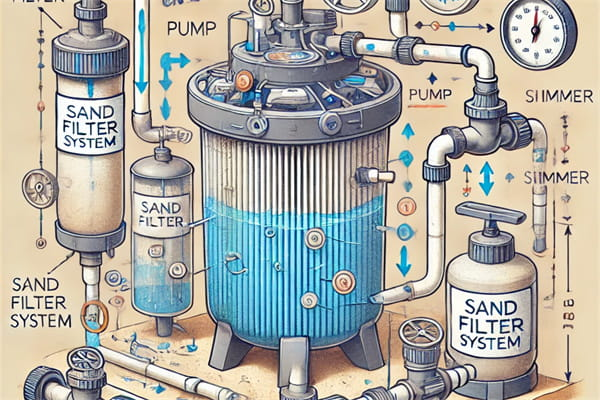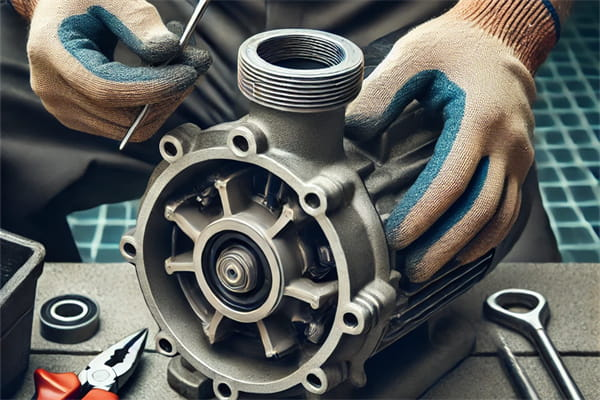Maintaining a pristine swimming pool is a delightful part of summer, but encountering issues like a reduced flow rate in your pool sand filter can quickly turn your oasis into a murky mess. A well-functioning pool sand filter is crucial for keeping your water clean and clear, but when the flow rate drops, so does the filter’s efficiency. In this blog, we’ll dive into the possible causes of a reduced flow rate, how to solve these problems, and tips for preventing them in the future. Let’s get started!
Possible Causes of Reduced Flow Rate
1. Clogged Sand Filter:
Over time, your pool sand filter can become clogged with debris, dirt, and oils. These contaminants build up in the sand, reducing its ability to filter the water effectively. A clogged filter forces the pump to work harder, decreasing the overall flow rate.
2. Pump Issues:
Your pump is the heart of your pool’s circulation system. If it’s not working correctly or is improperly sized for your pool, it can fail to generate the necessary flow. Issues like a broken impeller or an undersized pump can significantly impact performance.

3. Blocked or Dirty Skimmer and Pump Baskets:
The skimmer and pump baskets are designed to catch large debris before it reaches the filter. When these baskets become full or blocked, water flow is restricted, leading to a reduced flow rate in the filter system.
4. Incorrect Valve Settings:
Pool filters have several valves that control the flow of water. If these valves are not set correctly, they can restrict water flow through the filter system, causing a drop in efficiency.
5. Air Leaks in the System:
Air leaks in the pump or filter system can lead to a reduction in water flow. These leaks can occur at various points, such as the pump lid, valves, or fittings, allowing air to enter the system and disrupt the water flow.
6. Worn Out or Damaged Sand:
The sand in your filter doesn’t last forever. Over time, it can become worn out or damaged, losing its ability to filter water effectively. Typically, sand should be replaced every 3-5 years, depending on usage and water quality.
How to Address the Issue
1. Backwashing the Filter:
Regularly backwash your pool sand filter to remove accumulated debris. Backwashing reverses the flow of water through the filter, flushing out contaminants and restoring flow rate. This process should be part of your routine maintenance schedule.
2. Inspecting and Cleaning the Pump:
Check your pump for any signs of wear or blockage. Ensure that it is the right size for your pool and operating correctly. Cleaning the pump impeller and other components can help improve water flow.

3. Clearing Skimmer and Pump Baskets:
Routinely empty and clean the skimmer and pump baskets. This simple task can prevent blockages and maintain optimal water flow. Make it a habit to check these baskets weekly, especially during peak swimming season.
4. Adjusting Valve Settings:
Verify that all valves are set correctly to ensure unimpeded water flow through the system. Consult your pool’s manual for the proper valve positions or seek advice from a pool professional if you’re unsure.
5. Checking for Air Leaks:
Inspect your pump and filter system for any air leaks. Common places to check include the pump lid, fittings, and valves. Use a soapy water solution to detect leaks by looking for bubbles forming at potential leak points.
6. Replacing Sand:
If your sand is old or damaged, it may be time to replace it. Typically, this should be done every 3-5 years. New sand will improve the filter’s efficiency and restore proper flow rate. Follow the manufacturer’s instructions for replacing the sand in your filter.
Preventing Reduced Flow Rate in the Future
1. Regular Maintenance Schedule:
Establish a routine maintenance schedule for your pool sand filter. This should include backwashing, inspecting the pump, and cleaning skimmer and pump baskets. Consistent maintenance can prevent many common issues and keep your filter running smoothly.
2. Monitoring Water Chemistry:
Maintain balanced pool water chemistry to prevent scale and debris buildup in the filter. Imbalanced water can lead to scale formation, which can clog the filter and reduce flow rate. Regularly test your water and adjust chemicals as needed.
3. Properly Sizing Equipment:
Ensure your pump and filter are appropriately sized for your pool. An undersized pump or filter can struggle to keep up with the water volume, leading to decreased flow rate and reduced filtration efficiency. Consult with a pool professional to confirm you have the right equipment.
4. Using Pool Covers:
Utilize pool covers to minimize debris entering the pool. This simple step can reduce the load on your filter and extend the time between cleanings. A pool cover also helps maintain water temperature and reduces evaporation, saving you money on heating and water costs.
5. Educating Pool Users:
Encourage pool users to rinse off before swimming. This can decrease the amount of oils, dirt, and debris entering the pool, which in turn reduces the load on your filter. A quick rinse can go a long way in maintaining water quality and filter efficiency.